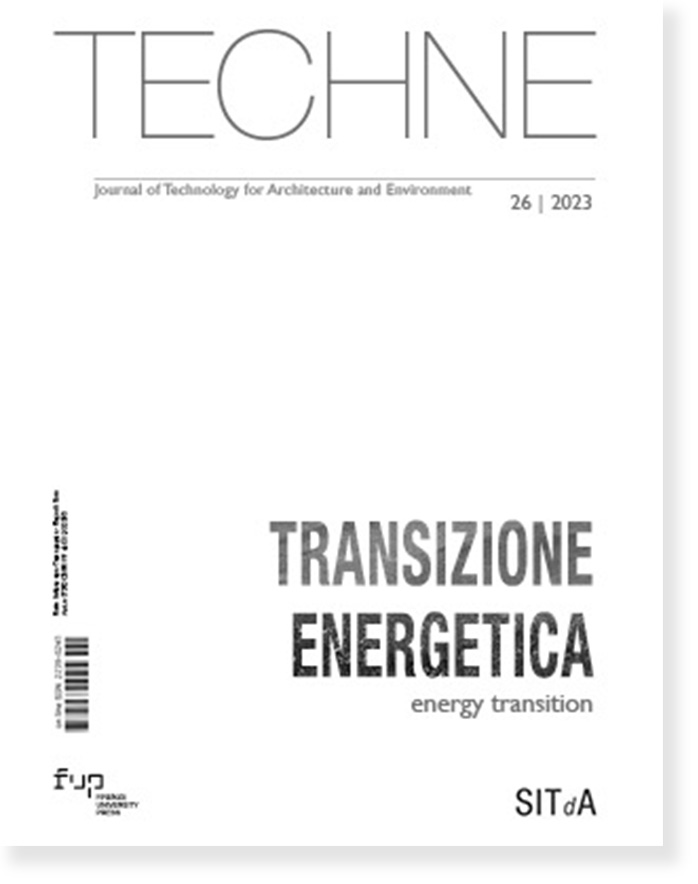Published 2023-10-31
Keywords
- Icons of Transition,
- Environmental Impacts,
- Place Attachment,
- Low Carbon Plants,
- Nimby
How to Cite
Copyright (c) 2023 Federico Di Cosmo

This work is licensed under a Creative Commons Attribution 4.0 International License.
Abstract
It is by now well established that the ecological transition is first and foremost a cultural transition. Like any radical change, it produces symbols, which are hard to process at the time they are created. Thus, it is not a coincidence that renewable energy facilities (solar power plants, wind farms, photovoltaic and waste-to-energy plants) generate concern and mistrust among communities and open up crucial debates about the protection and identity of the landscape. The text presents a critical viewpoint on the possibility of breaking down social barriers by opening up a field of design, which has so far been the exclusive domain of engineering to both architecture and art.
Downloads
References
2. Pasqualetti, M. (1980). “Geothermal energy and the environment: The global experience”. Energy, Vol. 5, n. 2, pp. 111–165. Available at: https://doi.org/10.1016/0360-5442(80)90004-3 (Accessed on: 15/02/2023).
3. Pasqualetti, M. (2011). “Social barriers to renewable energy landscapes”. Geographical Review, Vol. 101, n. 2, pp. 201–223. Available at: https://doi.org/10.1111/j.1931-0846.2011.00087.x (Accessed on: 15/02/2023).
4. Mumford, L. (1968), Tecnica e cultura, Il Saggiatore di Alberto Mondadori Editore, Milano.
5. Giallocosta, G., and Picardo, C. (2014). “Integrazione architettonica di tecnologie da fonti rinnovabili: rapporti con i fattori percettivi e orientamenti per linee-guida operative”. TECHNE, n. 7, pp. 165–172. Available at: https://oaj.fupress.net/index.php/techne/article/view/4362/4362 (Accessed on: 15/02/2023).
6. Marrone, G. (2011). Addio alla natura, Einaudi, Torino.
7. Magnani, N. (2021). “Civil Society and Conflicts Over Renewable Energies Beyond the NIMBY Syndrome”, in Magnani, N. and Carrosio G. (Ed.), Understanding the Energy Transition, Palgrave Macmillan, Cham, pp. 27-52. Available at: https://link.springer.com/chapter/10.1007/978-3-030-83481-4_3#citeas (Accessed on: 15/02/2023).
8. Ferrario, V. (2018). “Il paesaggio come strumento. Il caso delle energie rinnovabili”. Ri-Vista, n. 2, pp. 34-51. Available at: https://doi.org/10.13128/RV-24893 (Accessed on: 15/02/2023).
9. Schwenkenbecher, A. (2017). “What is wrong with Nimbys? Renewable energy, landscape impacts and incommensurable values”. Environmental Values, Vol. 26, n. 6, pp. 711-732. Available at: https://doi.org/10.3197/096327117X15046905490353 (Accessed on: 15/02/2023).
10. Warren, C. R., and McFadyen, M. (2010). “Does community ownership affect public attitudes to wind energy? A case study from south-west Scotland”. Land Use Policy, Vol. 27, n. 2, 204-213. Available at: https://doi.org/10.1016/j.landusepol.2008.12.010 (Accessed on: 15/02/2023).
11. Butera, F. M. (2022). “L’evoluzione del paesaggio nella transizione ecologica”. Rivista Di Storia Delle Idee, Vol.11, n. 2, pp. 4-10. Available at: https://doi.org/10.4474/DPS/11/02/DSS575/07 (Accessed on: 15/02/2023).
12. Liva, G. (2020). “Se il paesaggio marino cambia”. Radarmagazine.net. Available at: https://www.radarmagazine.net/se-il-paesaggio-marino-cambia/ (Accessed on: 15/02/2023).
13. Mariutti, E. (2018). “Transizione ed estetica: tra storia e innovazione per l’Italia il contrasto è proficuo”. Qualenergia.it. Available at: https://www.qualenergia.it/articoli/20180116-transizione-ed-estetica-tra-storia-e-innovazione-l-italia-il-contrasto-e-proficuo/ (Accessed on: 15/02/2023).
14. Walsh, N. P. (2021). “The Architect’s Power in Tomorrow’s Energy Infrastructure”. Archinect.Com. Available at: https://archinect.com/features/article/150283576/the-architect-s-power-in-tomorrow-s-energy-infrastructure (Accessed on: 15/02/2023).
15. Legambiente. (2021). Scacco matto alle rinnovabili. Available at: https://www.legambiente.it/rapporti-e-osservatori/scacco-matto-alle-rinnovabili/ (Accessed on: 15/02/2023).






